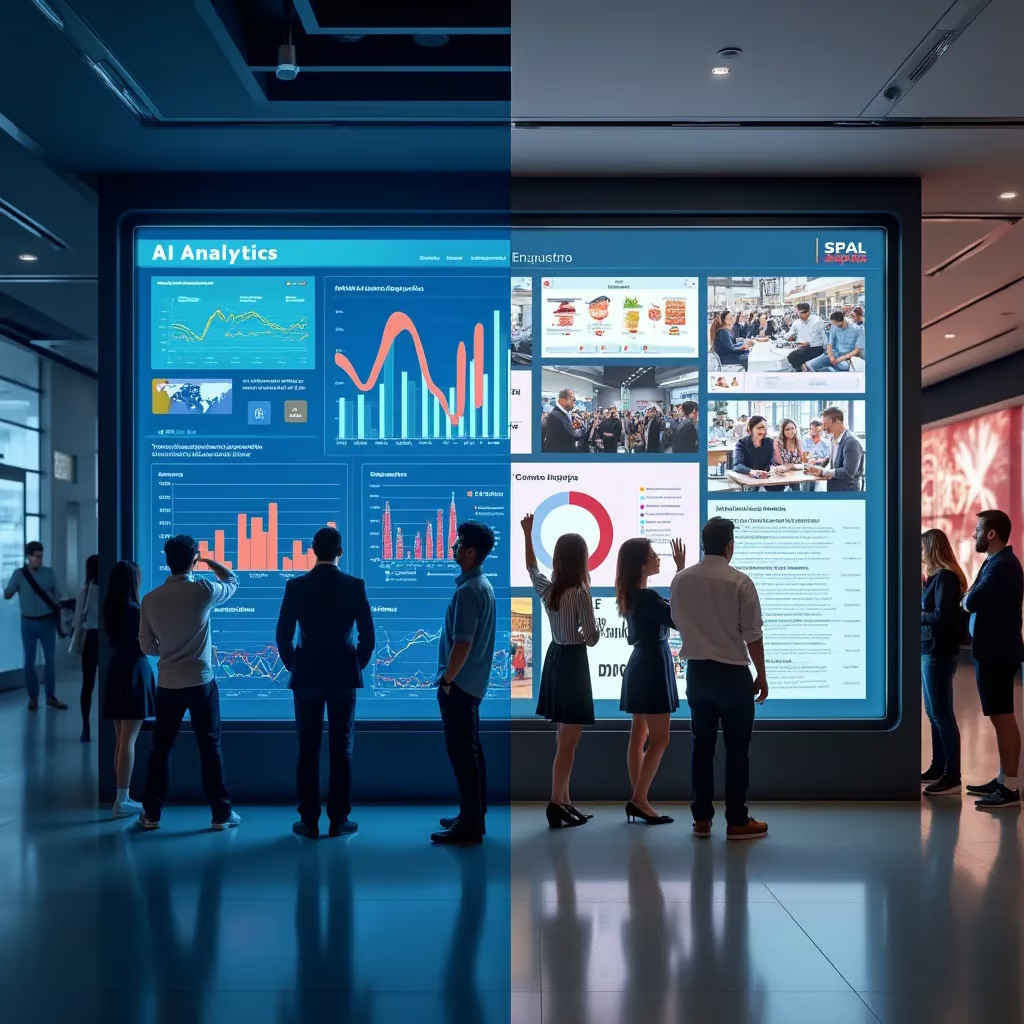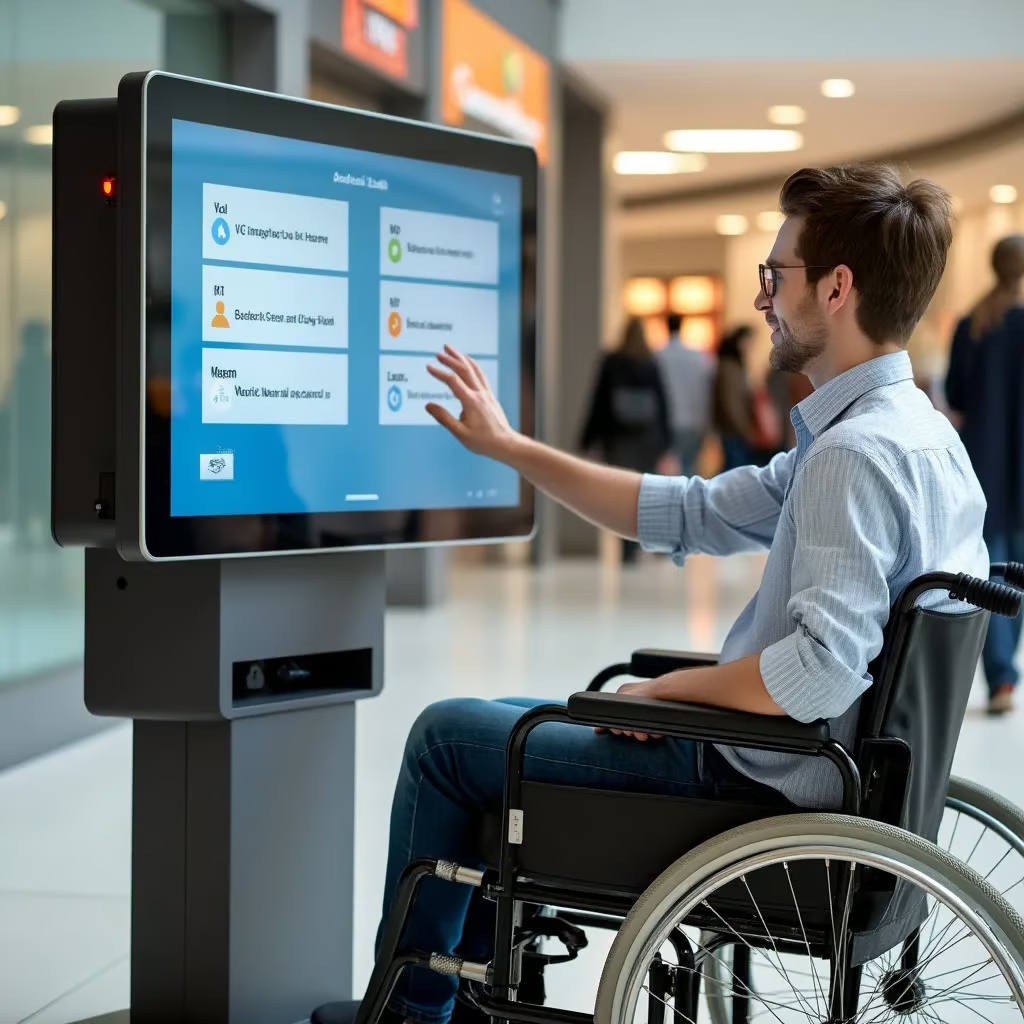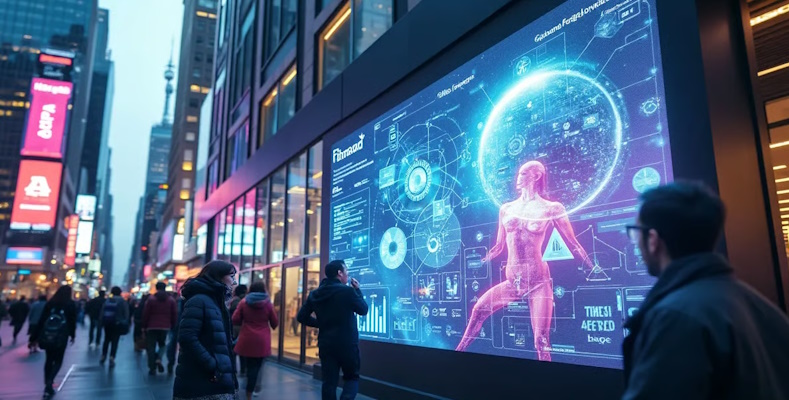AI Innovations in Digital Signage: Revolutionizing Audience Engagement
The landscape of digital signage has undergone a seismic shift in recent years, propelled by the integration of Artificial Intelligence (AI). This technological revolution has redefined the possibilities of audience engagement, transforming static displays into dynamic, responsive, and intelligent communication platforms. As we delve into the world of AI-powered digital signage, we'll explore how these innovations are reshaping industries, enhancing customer experiences, and providing unprecedented insights into audience behaviour.
From retail environments to corporate communications, transportation hubs to healthcare facilities, AI-driven digital signage is making its mark across diverse sectors. This article will take you on a journey through the cutting-edge AI technologies that are at the forefront of this transformation, showcasing real-world applications and the tangible benefits they bring to businesses and consumers alike.
Computer Vision: The Eyes of AI in Digital Signage
At the heart of AI-powered digital signage lies computer vision technology. This sophisticated system acts as the 'eyes' of the signage, capturing and analysing visual data in real-time. Let's explore how computer vision is revolutionizing audience engagement:
Demographic Analysis
Advanced algorithms can now accurately estimate age ranges and identify gender, allowing for highly targeted content delivery. For instance, a digital billboard in a shopping mall might display teen fashion ads when it detects a group of younger viewers, then switch to luxury watch advertisements when older professionals pass by.
Emotion Recognition
By analysing facial expressions, AI can gauge emotional responses to displayed content. This feedback loop enables real-time content optimization. Consider a digital menu board in a fast-food restaurant that notices customers frowning at a new item – it could automatically adjust the display to highlight more popular options.
Attention Tracking
AI can measure how long viewers engage with specific content, providing valuable data on what captures and holds attention. For example, a museum could use this technology to determine which digital exhibits are most engaging, informing future content creation and layout decisions.
Crowd Analysis
In large venues, AI can analyse crowd density and flow patterns. This data can be used to manage queues, optimize traffic flow, or even trigger safety protocols. Imagine a digital signage system in an airport that automatically directs passengers to less crowded security checkpoints during peak hours.
Real-Time Content Personalization: Tailoring Messages to the Moment
The true power of AI in digital signage lies in its ability to process data instantly and adjust content in real-time. This capability enables a level of personalization previously unimaginable in out-of-home advertising and information display.
Dynamic Content Adaptation
AI systems can instantly adjust displayed content based on various factors:
- Viewer demographics and emotions
- Time of day and day of the week
- Weather conditions
- Local events or news
For example, a digital billboard near a stadium might display traffic information and parking availability before a game, switch to food and beverage ads during the event, and show celebratory content for the winning team's fans afterwards.
Contextual Relevance
AI can analyse multiple data points to ensure content is not just personalized, but contextually relevant. A smart bus shelter display might show umbrella ads when rain is forecast, sunscreen promotions on hot days, and adjust content based on the next arriving bus route.
"AI in digital signage is not just about displaying content; it's about creating intelligent, responsive environments that adapt to and engage with viewers in real-time. We're moving from one-way communication to a dynamic dialogue between brands and their audiences."
Dr. Sarah Chen, AI and Digital Media Expert
Natural Language Processing: Enabling Interactive Experiences
Natural Language Processing (NLP) is bringing a new dimension of interactivity to digital signage, enabling voice-activated displays that can understand and respond to viewer queries. This technology is opening up new possibilities for engagement and accessibility.
Voice-Activated Information Kiosks
In large venues like shopping malls or airports, NLP-powered kiosks can provide personalized assistance. Visitors can ask questions about store locations, flight information, or available services, receiving instant, accurate responses.
Multilingual Support
NLP enables digital signage to communicate in multiple languages, breaking down language barriers in diverse environments. For instance, a tourist information display in a popular city center could detect the language spoken and provide information accordingly.
Accessibility Features
Voice-activated displays can greatly enhance accessibility for visually impaired users. A digital signage system in a public library could offer audio descriptions of books, reading out summaries or even full texts upon request.


Predictive Analytics: Anticipating Audience Needs
The power of AI in digital signage extends beyond real-time reactions to include predictive capabilities. By analysing historical data and identifying patterns, AI systems can anticipate future behaviors and preferences.
Content Optimization
Predictive analytics can forecast which types of content are likely to perform best at different times and locations. For example, a network of digital billboards could automatically adjust its content schedule to show ads for coffee shops during the morning commute and restaurants during lunch hours.
Inventory Management
In retail environments, AI can predict product demand based on signage engagement and adjust digital displays accordingly. A clothing store might promote winter coats more heavily if the system predicts an upcoming cold snap, based on weather data and historical sales patterns.
Traffic Flow Optimization
In transportation hubs, predictive analytics can anticipate crowd movements and adjust wayfinding signage to prevent congestion. An AI system in a subway station could direct passengers to less crowded platforms or exits based on historical data and real-time crowd analysis.
Industry-Specific Applications and Use Cases
The versatility of AI-powered digital signage allows for innovative applications across various industries. Let's explore some specific use cases:
Retail: Personalized Shopping Experiences
In the retail sector, AI-driven digital signage is transforming the shopping experience:
- Smart Fitting Rooms: Mirrors equipped with AI can suggest complementary items based on what a customer is trying on.
- Dynamic Pricing: Digital price tags can adjust in real-time based on demand, inventory levels, or competitor pricing.
- Virtual Try-On: AI-powered displays allow customers to virtually try on clothes, accessories, or makeup without physical samples.
For instance, Sephora's Virtual Artist kiosks use AI and augmented reality to allow customers to try on makeup virtually, significantly enhancing the shopping experience and reducing the need for physical testers.
Healthcare: Improving Patient Experience and Operations
In healthcare settings, AI-integrated digital signage is enhancing both patient care and operational efficiency:
- Waiting Room Management: AI can estimate wait times and display them accurately, reducing patient frustration.
- Wayfinding: Interactive maps can guide patients to their destinations within complex hospital layouts.
- Health Information: Displays can show personalized health tips based on the demographics of viewers in the waiting area.
The Cleveland Clinic, for example, uses AI-powered digital signage to manage patient flow, provide estimated wait times, and display targeted health information in waiting areas.
Transportation: Enhancing Travel Experiences
In the transportation sector, AI is revolutionizing how information is delivered to travellers:
- Real-time Updates: Displays can show live updates on delays, gate changes, and weather conditions.
- Personalized Advertising: Ads can be targeted based on flight destinations or passenger demographics.
- Interactive Assistance: AI-powered kiosks can provide voice-activated help for booking, check-in, and navigation.
Heathrow Airport in London utilizes AI-driven digital signage to manage passenger flow, provide real-time flight information, and deliver targeted advertising based on flight destinations.
Challenges and Considerations
While the potential of AI in digital signage is immense, there are several challenges and considerations to keep in mind:
Privacy Concerns
The use of cameras and sensors for audience analysis raises important privacy questions. It's crucial for businesses to be transparent about data collection and ensure compliance with regulations like GDPR.
Data Security
With the increasing amount of data collected and processed, ensuring robust cybersecurity measures is paramount to protect both business and consumer information.
Technical Challenges
Implementing AI-powered digital signage requires significant technical infrastructure. Issues like network reliability, processing power, and system integration need to be carefully addressed.
Content Creation
While AI can optimize content delivery, creating high-quality, diverse content to feed these systems remains a challenge. Businesses need to invest in content creation strategies that can keep pace with AI's capabilities.
Future Trends: The Next Frontier of AI in Digital Signage
As AI technology continues to evolve, we can expect even more innovative applications in digital signage:
Augmented Reality Integration
The combination of AI and AR could create immersive, interactive experiences. Imagine digital signage that can project personalized, 3D product demonstrations based on viewer preferences.
Emotional AI
Advancements in emotion recognition could lead to signage that not only detects but also responds to complex emotional states, creating highly empathetic interactions.
IoT Integration
As the Internet of Things expands, digital signage could become part of a broader ecosystem of smart devices, sharing data and creating seamless experiences across multiple touchpoints.
Edge Computing
The shift towards edge computing could enable faster, more localized processing of AI algorithms, reducing latency and improving real-time responsiveness of digital signage systems.
As we look to the future, it's clear that AI will continue to be a driving force in the evolution of digital signage. From enhancing audience engagement to providing unprecedented levels of personalization, AI is setting new standards for effective communication in the digital age. For businesses looking to stay ahead in this rapidly changing landscape, embracing AI-powered digital signage is not just an option—it's a necessity for creating truly engaging, responsive, and effective viewer experiences.
The key to success lies in understanding the potential of these technologies, addressing the challenges they present, and continuously innovating to meet the changing needs of audiences. As AI continues to advance, we can expect digital signage to become even more intelligent, interactive, and integral to our daily lives, reshaping how we interact with information in public spaces.


 By Prosigns AI Media
By Prosigns AI Media